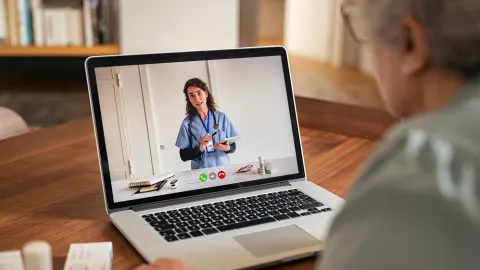It is clear that our health and care industry is in urgent need of transforming the way it delivers services and measures outcomes. Delivering sustainable transformation and managing capacity have long been areas of concern. Several years ago, the implementation of some digital solutions, such as remote consultation technologies (driven by a ‘need to change’) showed a willingness for the sector to embrace new approaches to better support citizens. COVID-19 provided the catalyst in that ‘need to change’ and accelerated the take-up of new ways of delivering care.
The pandemic was a major disruptive event that exacerbated existing tensions between planned and unplanned care. Precious resources were moved away from planned care to support the urgent demands of unplanned care. Now, unrelenting pressure persists on a committed workforce. However, while citizen empathy remains, frustrations, expectations and demands for services consistently increase.
People’s experiences of modernized services in other industries, such as retail and banking, demonstrate an ability to access such services, including self-service portals and apps on mobile devices, with suitable, proven technical support provided. These sectors provide enhanced, personalized digital services that improve customer experiences, as well as business outcomes. Understandably, there is a question as to why the health and care sector remains behind other industries’ transformation journeys.
Granted, health and care are complex. Although individuals may have multiple conditions, both chronic and acute, transformation is possible if carried out in a graceful, inclusive way that addresses patient and citizen needs. The needs and involvement of clinicians, as well as operational personnel who are responsible for making the system work and understand the processes, must also be considered. Additionally, understanding the status of the current technology is essential. Documenting all aspects of the ‘as is’ is required to move to the ‘to be.’ It’s difficult, if not impossible, to transform to a new state if the starting point is not understood.
Since the primary goal of our health and care sector is to support a healthier population, immediate action is required to address the needs of citizens, while simultaneously supporting the health and well-being of employees who work tirelessly to deliver quality experiences.
New models of health and care delivery - a more agile experience
 Staffing pressures, including staff shortages and the consistent need to work in emergency circumstances, have resulted in a need to review existing staffing levels and skills to establish new models of care with additional capacity and improved working experiences that better support employees. This alternative thinking is necessary across the whole health and care spectrum, and includes paid and unpaid care workers in a ‘whole system’ approach.
Staffing pressures, including staff shortages and the consistent need to work in emergency circumstances, have resulted in a need to review existing staffing levels and skills to establish new models of care with additional capacity and improved working experiences that better support employees. This alternative thinking is necessary across the whole health and care spectrum, and includes paid and unpaid care workers in a ‘whole system’ approach.
This whole system review must consider demographic changes, advances in medical treatments, the need to react to emergency situations and a more innovative use of finances to deliver transformed citizen- and employee-centric services. Empowering citizens in these new models of care will deliver the quality support they deserve and relieve the pressure on beleaguered and understaffed health and care workers, ultimately attracting new candidates to the redesigned work experience.
As stated, it is therefore important to review existing systems in their entirety to reimagine and design the ‘art of the possible,’ and then establish an effective path toward more agile health and care experiences. The main objective is to better manage those people who do not require face-to-face or hands-on support, thereby freeing up capacity for those who do.
To achieve this balance, it is essential to address the following features of the patient journey, whether dealing with acute conditions that may need elective interventions, or chronic conditions that need lifetime interventions.
- Care pathways - Consideration of clinical guidelines and national screening programs. Integration can play a big part to enable better signposting and access to information via self-service portals and digital consultations.
- Patient flow - Addressing how those needing face-to-face support can be effectively and efficiently managed and served using all available health and care assets to deliver the required quality outcome, whether at home or in hospital.
- Person-centric flow – Integrating both informal and formal care, signposting and self-management across the whole system to address individual health and care needs, as well as ultimately improving the overall well-being of the population.
Public-private-academic partnerships – impactful digitalization, innovation and research
 Simply adding new technologies to old ways of working, however, usually leads to increased costs and a belief that nothing has really changed. That’s why we take an ‘insights-driven, outcomes-based’ approach to digitally transforming our clients’ ways of working. This means first understanding the problems our clients face and the outcomes they need to achieve, and then applying the correct technology in an incremental way that considers the existing investment in legacy systems.
Simply adding new technologies to old ways of working, however, usually leads to increased costs and a belief that nothing has really changed. That’s why we take an ‘insights-driven, outcomes-based’ approach to digitally transforming our clients’ ways of working. This means first understanding the problems our clients face and the outcomes they need to achieve, and then applying the correct technology in an incremental way that considers the existing investment in legacy systems.
To effectively transform health and care services to benefit citizens and staff, we need to gain a full understanding of what is happening within the system. Only with a complete understanding of the existing model can we then apply digital transformation to address blockages and bottlenecks.
Technology alone is not the answer to the challenges faced by the health and care sector. Digital transformation must be coupled with people and process transformation if it is to succeed. Together, new technological advances, innovations and research developments are the fundamental building blocks that will enable the digitalization of health and care. These areas must consider and combine the needs of citizens, the strengths of academia, and the ‘art of the possible’ from the private sector to redesign a delivery model that effectively supports citizens needing health and care services, while empowering the workforce at the heart of delivering them.
If you want to know more about how we can support your digital transformation journey, please explore our global health page. For the UK, please visit our Health and Care Advisory Services page.






